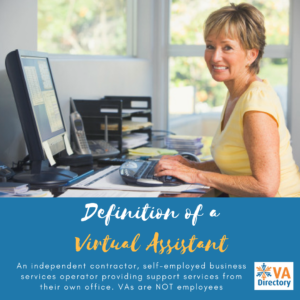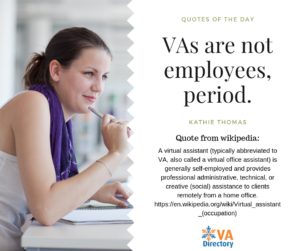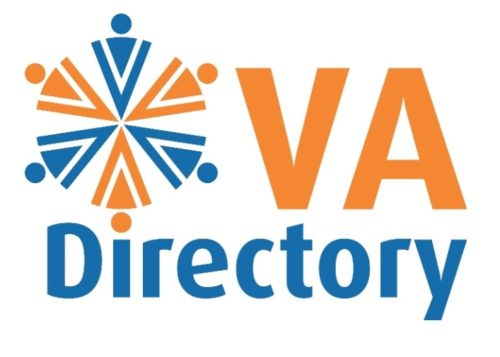


Once again the topic about employee vs contractor raises its head. It gets particularly complicated here in Australia, for example, when our tax office (ATO) confuses the general public out there what it means. And then we also get remote offshore employees who work for agencies, charging very low hourly/weekly/monthly rates providing similar services. And yet they are employees, not Virtual Assistants. The terminology gets mixed up and confused. And then enter tech gadgets that go by the name of ‘virtual assistant’ (think chatbot) and it adds another dimension.
The definition of an occupational Virtual Assistant on Wikipedia defines a VA as someone who is generally self-employed and provides administrative support services. It also goes on to say that we VAs are responsible for our own taxes, insurances, etc and that clients pay us a fee or rate or charge – not a wage.
I have shared all three images above via Facebook and LinkedIn and had some interesting commentary. Things relating to business owners here in Australia being confused and being scared that the ATO will deem them an employer, hence why they engage someone offshore. But many of us in the industry here in Australia feel the truth is that they just want to engage someone full time at a very cheap rate and get away without having to pay taxes, Super, leave pay and so on. The reality is that if they engaged a VA here in Australia the work would probably be completed much faster and they really only have to pay for the work or time carried out rather than trying to keep someone busy full time because they’ve engaged them full time.
Virtual Assistants are self-employed business owners and, therefore, service multiple clients. Just like all business owners do. Rarely does any business owner have only one client – otherwise they have no business! They have a job with an employer. And, just as in the corporate world, there is often need for more than one administrative person to fulfill the needs in a business. While it’s true that the VA Industry, collectively, can carry out a lot of roles, it does not mean that any one particular VA can do everything. You may choose to engage a virtual bookkeeper/VA, a VA for managing your social media, another VA to do your general admin including broadcast emails and phone answering, and perhaps a fourth to manage your website or do copywriting or something else. There are even VAs who work in the Human Resources field. A Virtual Assistant is an Assistant or Worker who works on a Virtual basis. They’re not a subordinate, or employee but rather, just like you, they’re a business owner who provides services to help you run your business. They’re there to help free up your time so you can concentrate on earning more in your business while the back end of the business is being maintained. They are experienced and used to holding the fort and keeping things running, usually with minimal guidance, once they understand your business needs.
Another comment made to me related to a ‘client’ having to pay our Super if we were earning more than $450 per month from that one source, but in checking about that via my own Accountant, I found that was actually just a very simplified response and it goes much deeper than that. The ATO explanation is here. And then Jenniffer Crowley added her own experience at LinkedIn in relation to subbing out work to others and the difference between employing and contracting support staff. You can read about it here.
For those who don’t want to follow the links and are looking for the shorter answer – here it is below. Basically, if the contractor (read self-employed business owner/operator or Virtual Assistant) is responsible for the following things – you are engaging a contractor and not an employee.
- The contractor has the ability to subcontract or delegate the work to others (an employee can’t)
- The contractor owns their own equipment, software, and other tools to carry out the work in most cases (occasionally a client may reimburse for purchase of specific software or program relating to their particular need)
- The contractor is legally responsible for the work they carry out and fixes errors at their own cost
- The contractor is free to determine how the work is carried out and when, subject to any contract or agreement they have with their client
- The contractor operates their business independently of the client and is free to take on other clients and other work
- The contractor usually advertises their business to grow their client base
- The contractor usually carries their own insurances, i.e. business equipment, personal indemnity, etc
- The contractor maintains their own records and usually has a separate bank account for their business activities
- The contractor is paid to achieve a result. That is, they are not typically paid for time but to produce something, say a report, meeting minutes or whatever is relevant.
Of course, there could be exceptions to the rule and it’s always best to confirm with your own Accountant about your own situation. But then, as business owners, we all do have Accountants, don’t we? And I know they have to keep updated with the rules and regulations on a regular basis. I know my own Accountant does receive updated training each year – hopefully yours does too.

Kathie is the former owner of VA Directory and is former past President of the Australian VA Association. She founded the Virtual Assistant industry in Australia in the mid 90s, having already been operating a home-based secretarial service. Today the VA industry covers a multitude of office-based services for clients worldwide.

Linda Heidstra says
Thank you Kathie for your efforts in explaining all this about our network of VA’s. A very important difference.
Kind Regards
Linda